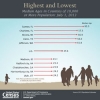Mar242016
Posted at 10:34 AM
Four Texas metro areas together added more people last year than any state in the country except for Texas as a whole, according to new U.S. Census Bureau population estimates released today. The population in these four metro areas increased by more than 400,000 people from July 1, 2014, to July 1, 2015.
The Houston-The Woodlands-Sugar Land and Dallas-Fort Worth-Arlington metro areas added about 159,000 and 145,000 residents, respectively — the largest gains of any metro areas in the nation. Two additional Texas metro areas adjacent to each other — Austin-Round Rock and San Antonio-New Braunfels — were each also among the 16 nationwide to gain 50,000 or more people over the period.
These four Texas metro areas collectively added about 412,000 people. Texas as a whole gained about 490,000.
The statistics released today provide population estimates for our nation’s 381 metropolitan statistical areas, 536 micropolitan statistical areas and 3,142 counties.
The Villages, Fla., a metro area west of the Orlando metro area, was the nation’s fastest-growing metro area for the third year in a row, as its population increased 4.3 percent between 2014 and 2015. It was joined in the top 20 by five others in the Sunshine State: Cape Coral-Fort Myers, Punta Gorda, North Port-Sarasota-Bradenton, Orlando-Kissimmee-Sanford and Naples-Immokalee-Marco Island.
Five Texas metros — Midland, Odessa, Austin, College Station-Bryan and Houston — were also among the 20 fastest growing between 2014 and 2015.
In addition to growth in several metro areas in Florida and Texas, three metro areas partially or completely within South Carolina were among the 20 fastest growing between 2014 and 2015:
Myrtle Beach-Conway-North Myrtle Beach, S.C.-N.C. (which ranked second nationally), Hilton Head Island-Bluffton-Beaufort and Charleston-North Charleston.
Houston, Austin and Orlando were the only three metro areas nationwide to be among both the 20 with the largest numeric gains and the 20 fastest growing (percentage gain) between 2014 and 2015.
Counties
- Los Angeles, Calif., is still the nation’s most populous county with 10.2 million people on July 1, 2015.
- The nation’s second-most populous county — Cook, Ill. — experienced its first population decline since 2007: 10,488 between 2014 and 2015 to 5.2 million.
- Two counties passed the 1 million population milestone between 2014 and 2015: Fulton, Ga., which is home to Atlanta (1,010,562), and Wake, N.C. (1,024,198). Wake, which includes Raleigh, was also the nation’s 19th largest numerical gainer among counties, adding nearly 25,000 people.
Metro areas
-
The nation’s metro areas contained 275.3 million people in 2015, an increase of about 2.5 million from 2014.
-
Most (285 of the 381) metro areas nationwide gained population between 2014 and 2015.
-
Four of the 20 fastest-growing metro areas between 2014 and 2015 were in the Mountain states: Greeley and Fort Collins in Colorado and St. George and Provo-Orem in Utah.
Micro areas
- The nation’s micro areas contained about 27.3 million people in 2015, an increase of around 27,000 from 2014.
- Nearly half the U.S. micro areas (261 of the 536) gained population between 2014 and 2015.
- North Dakota contained the nation’s two fastest-growing micro areas between 2014 and 2015: Williston and Dickinson, whose populations rose by 9.9 percent and 5.5 percent, respectively.
For more information, please see the latest press release from the U.S. Census Bureau on population estimates. In the coming months, the Census Bureau will release 2015 population estimates of cities and towns, as well as national, state and county population estimates by age, sex, race and Hispanic origin.




